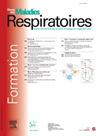Healthy and COPD iPSC derived lung organoids responds differently to SARS-CoV-2 infection
IF 0.5
4区 医学
Q4 RESPIRATORY SYSTEM
引用次数: 0
Abstract
Introduction
iALI is a model of multiciliated airway epithelium derived from human induced pluripotent stem cells and generated in an air-liquid interface culture. This in vitro lung model was developed to study airway pathologies and infectious diseases such as SARS-CoV-2.
Methods
iALI were produced with iPSCs dedifferentiated from either healthy or patients with chronic obstructive pulmonary disease (COPD). SARS-CoV-2 infection of both iALI was validated by RTqPCR, infection plaque assays and immunofluorescence coupled to 3D super-resolution confocal microscopy. In addition, the innate immune response of infected and uninfected iALI was measured by RTqPCR and immunoassays.
Results
We produced complete, functional bronchial epithelium; moreover, COPD iALI show hallmarks of the pathology: goblet cell metaplasia, basal cell hyperplasia and tissue inflammation. While both samples infect and replicate the virus for several weeks, with a peak 2 days after infection, viral production is limited in iALI COPD. Our results show expressions of interferon-stimulated genes (ISGs) and pro-inflammatory cytokines after infection with SARS-CoV-2 [1] and at a higher level in iALI with COPD.
Conclusion
In conclusion, our results show that iALI can be used to study respiratory virus infection and its consequences on lung tissue, including from patients with COPD pathology.
健康和COPD iPSC衍生的肺类器官对SARS-CoV-2感染的反应不同
ali是来源于人诱导多能干细胞的多纤毛气道上皮模型,并在气液界面培养中生成。该体外肺模型的建立是为了研究呼吸道病理和SARS-CoV-2等传染病。方法ali是用健康人或慢性阻塞性肺疾病(COPD)患者的去分化iPSCs制备的。通过RTqPCR、感染斑块测定和免疫荧光耦合3D超分辨共聚焦显微镜验证两种iALI的SARS-CoV-2感染。此外,采用RTqPCR和免疫分析法检测感染和未感染iALI的先天免疫反应。结果制备出完整、功能性支气管上皮;此外,慢性阻塞性肺疾病还表现出杯状细胞化生、基底细胞增生和组织炎症等病理特征。虽然两种样本都可感染并复制病毒数周,并在感染后2天达到高峰,但慢性阻塞性肺病患者的病毒产生有限。我们的研究结果显示,干扰素刺激基因(ISGs)和促炎细胞因子在sars - cov - 2[1]感染后表达,在iALI合并COPD患者中表达水平更高。总之,我们的研究结果表明,iALI可用于研究呼吸道病毒感染及其对肺组织的影响,包括COPD病理患者。
本文章由计算机程序翻译,如有差异,请以英文原文为准。
求助全文
约1分钟内获得全文
求助全文
来源期刊

Revue des maladies respiratoires
医学-呼吸系统
CiteScore
1.10
自引率
16.70%
发文量
168
审稿时长
4-8 weeks
期刊介绍:
La Revue des Maladies Respiratoires est l''organe officiel d''expression scientifique de la Société de Pneumologie de Langue Française (SPLF). Il s''agit d''un média professionnel francophone, à vocation internationale et accessible ici.
La Revue des Maladies Respiratoires est un outil de formation professionnelle post-universitaire pour l''ensemble de la communauté pneumologique francophone. Elle publie sur son site différentes variétés d''articles scientifiques concernant la Pneumologie :
- Editoriaux,
- Articles originaux,
- Revues générales,
- Articles de synthèses,
- Recommandations d''experts et textes de consensus,
- Séries thématiques,
- Cas cliniques,
- Articles « images et diagnostics »,
- Fiches techniques,
- Lettres à la rédaction.
 求助内容:
求助内容: 应助结果提醒方式:
应助结果提醒方式:


